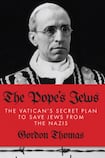
On first impression, Gordon Thomas, the prolific investigative writer of works such as Pontiff (1983), about the assassination attempt against John Paul II, appears to have returned to his study of the papacy by involving himself in the so-called Pius Wars, about the historical reputation of Pius XII. Certainly, the title of this book gives the impression that Thomas intends to enter the fray by presenting the case for an activist pope out to save Jews from the Nazis and thereby to counter those who castigate Pius XII for his silence about the Holocaust.
Such, however, is a misleading impression of the author's intention. There is no question that Thomas is sympathetic to Pius XII, but he is prepared to accept at face value the pope's reluctance to challenge the Nazis and fascists in diplomatic and political terms and to move on to examine what the Vatican and the Italian church actually did to help and save both Jews and escaped Allied prisoners of war from German vengeance in Rome.
Thomas does a good job of creating a sense of the community in Rome during the second World War and the way it dealt with crises occasioned by the Allied bombing of Rome, the German occupation and the roundup of the Roman Jews on October 16th, 1943. He claims that “this book is ultimately the story of the people of the Rome ghetto. Theirs is a microcosm of a cruel and unjust time”.
Thomas is particularly interested in the networks and other connections between groups such as the papal household, the Jewish community, the “black aristocracy” of pro-papal nobles and the local bishops and clergy. He introduces us to an assortment of colourful individuals, including Israel Zolli, chief rabbi of Rome, who became a convert to Catholicism; Herbert Kappler, head of the Roman Gestapo; Sr Pascalina, the pope’s housekeeper; D’Arcy Osborne, British minister to the holy see; and Dr Giovanni Borromeo, director of the Fatebenefratelli Hospital, on Tiber Island, which managed to hide a number of Jews during the German occupation.
Central to the narrative is Pope Pius XII, who was attempting to provide leadership to his church in the chaos of wartime and to provide humanitarian assistance to those suffering the cruelties of that war. Although the pope was unprepared to challenge the perpetrators of these cruelties, he was concerned that the suffering should be contained and lent his secret support and funding to the work of a variety of people who helped Jews to escape the Holocaust and anti-fascist soldiers and politicians to hide from their pursuers.
The pope encouraged the creation of a network to hide the fugitives in church buildings, monasteries and convents in Italy. According to Thomas, the pope was kept informed by his secretary and his housekeeper of the way the Vatican was able to help people in Rome during this trying time.
Thomas’s approach is that of the investigative reporter who conducts his research through interviews with participants in the events or members of their families and staffs.
This worked well in his book on the assassination attempt on John Paul II, which he wrote only two years after the event. He has approached this book similarly, listing 25 “researchers” at its beginning. Yet it lacks immediacy, as this is an attempt at investigative research 60 years after the events being described and after the subject has been well studied.
A journalist’s account is valuable soon after an event as it is able to draw together whatever evidence is available into an explanatory narrative when more scholarly studies have yet to be developed. One trusts the journalist and his respect for the evidence that his interviews have elicited.
In this book, Thomas has wandered into a field that has been studied by a variety of historians who have used the available documentary evidence, much of which is in the public domain. It would be interesting to know what his researchers have found out that is new about this period, but unfortunately he provides no precise indication of his sources. There are no footnotes, and there is only a short and loose discussion of sources at the end of the book.
Thomas's thesis of papal support for humanitarian activities is backed by similar research done by Susan Zuccotti in Under His Very Windows (2000) and Robert Ventresca in his recent biography Soldier of Christ: The Life of Pope Pius XII (2013). Zuccotti sought, without a great deal of success, to find specific evidence that Pius ordered the church to shelter the Jews. If Thomas has come across such evidence, he has done a disservice to historians by failing to share it with his readers.
As with other journalistic histories, one is expected to trust the objectivity and journalistic ethics of the writer. Yet Thomas makes it clear that he believes historians have given Pius XII a raw deal, and he is not above bolstering his case by being careless with the evidence, as when he claims that Pius gave the Jewish community 15kg of gold to enable them to pay off the German ransom in 1943. The fact is, according to Ventresca, that the pope offered the gold but the Jewish community found the required amount in other ways from other sources, and did not accept the offer.
In spite of these concerns, this book is a good read. Thomas writes well and frequently supplies imaginative details to paint pictures of individuals and their reactions to events. At times, his attempt to work so many characters into his narrative can be confusing, as he cuts from one group to another, but his list of the principal personae at the beginning of the book is a help.
Peter C Kent is emeritus professor of history at the University of New Brunswick, in Canada. His books include The Vatican and Italian Fascism , Papal Diplomacy in the Modern Age and The Lonely Cold War of Pope Pius XII .










